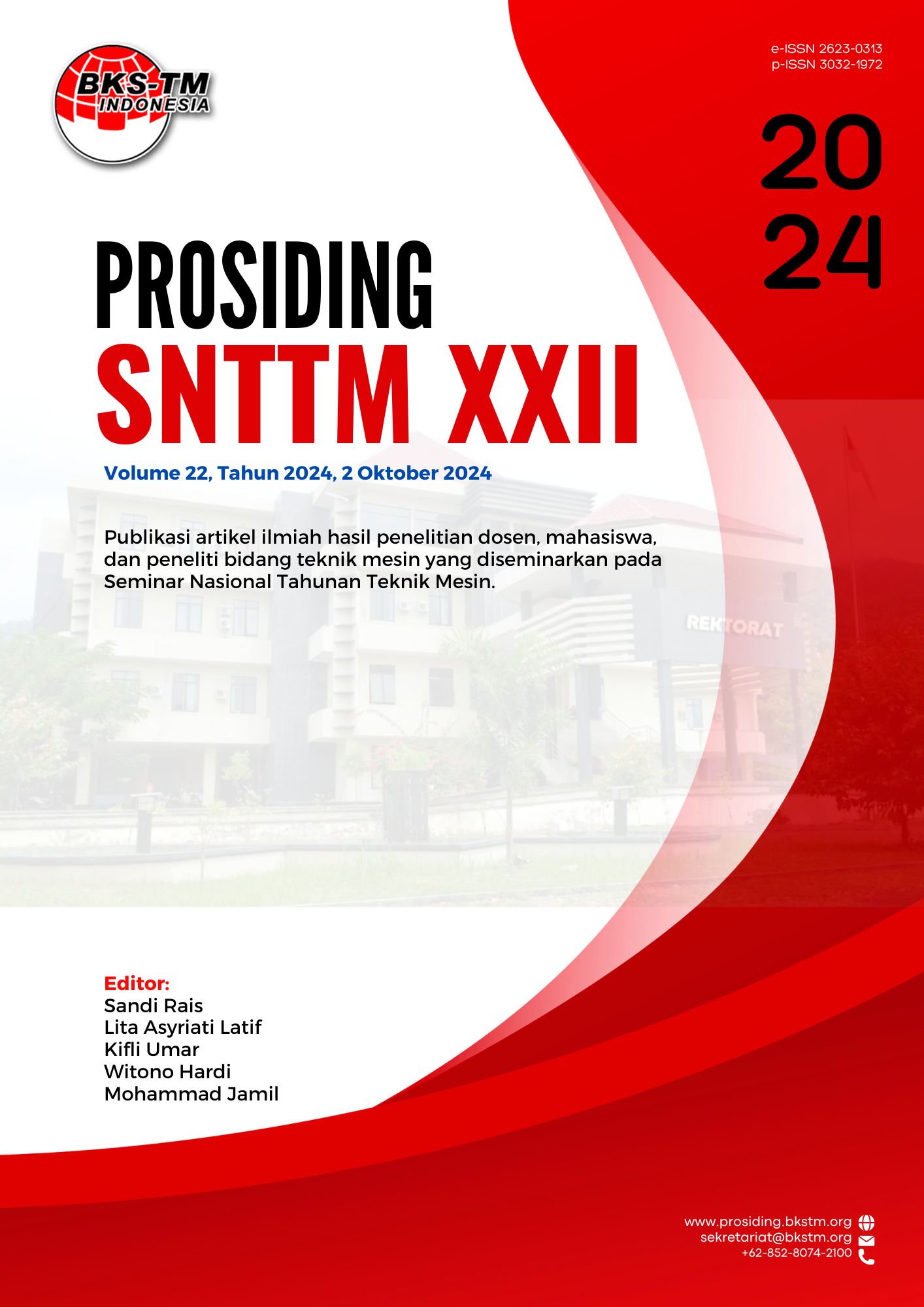Persalinan nyaman: Konsep tempat tidur otomatis berbasis pemrosesan gambar comfortable childbirth: The concept of an automated bed based on image processing
DOI:
https://doi.org/10.71452/590882Keywords:
C-section, Intrapartum, Automated birthing table, Image processing, Upright labour, Pain reduction.Abstract
In Indonesia, the rate of C-section births has increased to 16.4% in 26 years, exceeding the WHO recommendation of 15%, with 25% of these operations performed without medical emergencies. One of the causes is anxiety about labour pain and intrapartum discomfort. Bar-Lung, short for Babar Lungguh, is an automated birthing table system that supports upright labour. Bar-Lung uses image processing to reconstruct the mother's body geometry from the hips down to obtain the parturient's geometry measurements, then adjusts three main components—Back Lift, Leg Support, and Push Bar—for optimal positioning. Research shows that an upright position can facilitate the pushing process and reduce the duration
of the second stage, thereby reducing pain and increasing normal labour. Pregnant women are photographed with a calibrated camera layout and lighting and are shot from the side. The photos are processed to identify key points such as the knees, soles of the feet, and waist, which are then counted in pixels and converted to metric units. The measurement results are used to drive the Bar-Lung, which is equipped with a stable and efficient electric putter actuator. The Back Lift, Leg Support, and Push Bar components can be adjusted automatically or manually for fine tuning, while the Emergency button allows the birthing table position to be reset in case of emergency. The Bar-Lung makes childbirth easier and increases the efficiency of medical personnel, with the potential to reduce the number of Caesarean sections in
Indonesia by reducing the duration of labour pain.
References
Cox, K. J., & King, T. L. (2015). Preventing Primary Cesarean Births. Clinical Obstetrics & Gynecology, 58(2), 282-293. https://doi.org/10.1097/grf.0000000000000108
Dahlen, H. G., Homer, C. S. E., Cooke, M., Upton, A. M., Nunn, R., & Brodrick, B. (2007). Perineal Outcomes and Maternal Comfort Related to the Application of Perineal Warm Packs in the Second Stage of Labor: A Randomized Controlled Trial. Birth, 34(4), 282-290. https://doi.org/10.1111/j.1523-536X.2007.00186.x
Dreisbach, M., Blessing, S., Brunn, A., Michaux, F., Stroh, A., & Kriegseis, J. (2023). Three-Dimensional Encoding of a Gas–liquid Interface by Means of Color-Coded Glare Points. Experiments in Fluids, 64(3). https://doi.org/10.1007/s00348-023-03592-0
Eichelberger, P., Ferraro, M., Minder, U., Denton, T. A., Blasimann, A., Krause, F., & Baur, H. (2016). Analysis of Accuracy in Optical Motion Capture – A Protocol for Laboratory Setup Evaluation. Journal of Biomechanics, 49(10), 2085-2088. https://doi.org/10.1016/j.jbiomech.2016.05.007
El-Aziz, S. N. A., Mansour, S. E.-S., & Hassan, N. F. (2016). Factors associated with fear of childbirth: It’s effect on women’s preference for elective cesarean section. Journal of Nursing Education and Practice, 7(1). https://doi.org/10.5430/jnep.v7n1p133
Farghaly, T., Shaaban, O. M., Amen, A. F., Salem, H. T., Elnashar, I., Abdelaleem, A. A., & Badran, E. (2017). Evaluating the Role of Measuring the Perineal Length as a Predictor of Progress of Labor and Obstetrical Trauma. Open Journal of Obstetrics and Gynecology, 07(04), 464-472. https://doi.org/10.4236/ojog.2017.74048
Greenwald, A. (2023). Prompting and Modeling of Coping Strategies During Childbirth. Behavior Analysis in Practice, 17(1), 283-295. https://doi.org/10.1007/s40617-023-00837-6
Guang-Jiong, D., Ru-Shan, H., Yun, H., Sakatani, K., & Feng-yuan, Z. (2001). An Approach to Biochemical Imaging of Heterogeneity in the Bio-Tissue Simultaneously Using the Data of Reflectance and Transmittance of Diffuse-Photon Density Waves. Communications in Theoretical Physics, 35(3), 381-384. https://doi.org/10.1088/0253-6102/35/3/381
Inar Melati, F., Purwanto, B., & Umiastuti, P. (2024). Pregnancy Leave’s Impact on Energy Balance and Labor Period in Working Mothers. Indonesian Midwifery and Health Sciences Journal, 8(1), 12-23. https://doi.org/10.20473/imhsj.v8i1.2024.12-23
Islam, M. A., Shanto, H. H., Jabbar, A., & Howlader, M. H. (2022). Caesarean Section in Indonesia: Analysis of Trends and SocioDemographic Correlates in Three Demographic and Health Surveys (2007–2017). Dr. Sulaiman Al Habib Medical Journal, 4(3), 136-144. https://doi.org/10.1007/s44229-022-00011-0
Keen, R., DiFranco, J., Amis, D., & Albers, L. L. (2004). #5: Non-Supine (e.g., Upright or Side- Lying) Positions for Birth. The Journal of Perinatal Education, 13(2), 30-34. https://doi.org/10.1624/105812404982376
Kibuka, M., Price, A., Onakpoya, I., Tierney, S., & Clarke, M. (2021). Evaluating the Effects of Maternal Positions in Childbirth: An Overview of Cochrane Systematic Reviews. European Journal of Midwifery, 5(December), 1-14. https://doi.org/10.18332/ejm/142781
Kim, K. M., Choe, S.-H., Ryu, J. M., & Choi, H. (2020). Computation of Analytical Zoom Locus Using Padé Approximation. Mathematics, 8(4), 581. https://doi.org/10.3390/math8040581
Kjeldsen, L. S., Blankholm, A., Jurik, A. G., Salvig, J. D., & Maimburg, R. D. (2021). Pelvic Capacity in Pregnant Women, Identified Using Magnetic Resonance Imaging. Acta Obstetricia Et Gynecologica Scandinavica, 100(8), 1454-1462. https://doi.org/10.1111/aogs.14168
Kreienbühl, J., Rüegg, L., Balsyte, D., Vonzun, L., & Ochsenbein-Kölble, N. (2024). Duration of Labor in Consecutive Deliveries: A Retrospective Data Analysis. Archives of Gynecology and Obstetrics, 310(1), 469-476. https://doi.org/10.1007/s00404-024-07554-7
Lugaresi, C., Tang, J., Nash, H., McClanahan, C., Uboweja, E., Hays, M. L., . . . Grundmann, M. (2019). MediaPipe: A Framework for Building Perception Pipelines. https://doi.org/10.48550/arxiv.1906.08172
Marchi, J., Berg, M., Dencker, A., Olander, E. K., & Begley, C. (2015). Risks Associated With Obesity in Pregnancy, for the Mother and Baby: A Systematic Review of Reviews. Obesity Reviews, 16(8), 621-638. https://doi.org/10.1111/obr.12288
Michel, S., Rake, A., Treiber, K., Seifert, B., Chaoui, R., Huch, R., Kubik‐Huch, R. A. (2002). MR Obstetric Pelvimetry: Effect of Birthing Position on Pelvic Bony Dimensions. American Journal of Roentgenology, 179(4), 1063-1067. https://doi.org/10.2214/ajr.179.4.1791063
Mn, L., Pai, M., & Poojari, V. G. (2015). Relationship and Effect of Duration of First Stage of Labor on Second Stage. International Journal of Reproduction Contraception Obstetrics and Gynecology, 566-569. https://doi.org/10.18203/2320-1770.ijrcog20150052
Muhandule, C., Benetti, C. M. S., Fogulin, L. B., Bento, S. F., & Amaral, E. (2024). Caesarean delivery on maternal request: the perspective of the postpartum women. BMC Pregnancy Childbirth, 24(1), 257. https://doi.org/10.1186/s12884-024-06464-5
Mumtaz, S., Bahk, J., & Khang, Y. H. (2017). Rising trends and inequalities in cesarean section rates in Pakistan: Evidence from Pakistan Demographic and Health Surveys, 1990-2013. PLoS One, 12(10), e0186563. https://doi.org/10.1371/journal.pone.0186563
Papadias, K., Christopoulos, P., Deligeoroglou, E., Vitoratos, N., Makrakis, E., Kaltapanidou, P., Creatsas, G. (2006). Maternal Age and the Duration of the Second Stage of Labor. Annals of the New York Academy of Sciences, 1092(1), 414-417. https://doi.org/10.1196/annals.1365.039
Satone, P. D., & Tayade, S. (2023). Alternative Birthing Positions Compared to the Conventional Position in the Second Stage of Labor: A Review. Cureus. https://doi.org/10.7759/cureus.37943
Seidl, S., Hausmann, R., & Betz, P. (2007). Comparison of Laser and Mercury-Arc Lamp for the Detection of Body Fluids on Different Substrates. International Journal of Legal Medicine, 122(3), 241-244. https://doi.org/10.1007/s00414-007-0214-2
Shmueli, A., Salman, L., Orbach‐Zinger, S., Aviram, A., Hiersch, L., Chen, R., & Gabbay‐Benziv, R. (2018). The Impact of Epidural Analgesia on the Duration of the Second Stage of Labor. Birth, 45(4), 377-384. https://doi.org/10.1111/birt.12355
Sormin, M., Raja, S. L., & Fitria, A. (2022). Factors Affecting Antenatal Care Examination on Pregnant Women in the Work Area of Hinai Kiri Health Center, Langkat Regency. Journal La Medihealtico, 3(4), 256-268. https://doi.org/10.37899/journallamedihealtico.v3i4.682
Sugimura, R., Kohmura-Kobayashi, Y., Narumi, M., Furuta-Isomura, N., Oda, T., Tamura, N., Itoh, H. (2020). Comparison of Three Classification Systems of Prepregnancy Body Mass Index With Perinatal Outcomes in Japanese Obese Pregnant Women: A Retrospective Study at a Single Center. International Journal of Medical Sciences, 17(13), 2002-2012. https://doi.org/10.7150/ijms.47076
Sukasih, N. K., Maliga, I., & Kesuma, E. G. (2021). ANALISIS FAKTOR NON MEDIS YANG MEMPENGARUHI PERSALINAN SECTIO CAESARIA DI RUMAH SAKIT UMUM DAERAH SUMBAWA. Jurnal Kesehatan dan Sains, 4(1), 93-105. Retrieved from http://jurnal.lppmstikesghs.ac.id/index.php/jks/a rticle/view/65
Thies-Lagergren, L., Kvist, L. J., Christensson, K., & Hildingsson, I. (2011). No Reduction in Instrumental Vaginal Births and No Increased Risk for Adverse Perineal Outcome in Nulliparous Women Giving Birth on a Birth Seat: Results of a Swedish Randomized Controlled Trial. BMC Pregnancy and Childbirth, 11(1). https://doi.org/10.1186/1471-2393-11-22
Türkmen, H., Çetinkaya, S., Apay, E., Karamüftüoğlu, D., & Kılıç, H. (2020). The Effect of Perineal Warm Application on Perineal Pain, Perineal Integrity, and Postpartum Comfort in the Second Stage of Labor: Randomized Clinical Trial. Complementary Medicine Research, 28(1), 23-30. https://doi.org/10.1159/000507605
Yadav, J., Rani, A., Singh, V., & Murari, B. M. (2015). Prospects and Limitations of Non-Invasive Blood Glucose Monitoring Using Near- Infrared Spectroscopy. Biomedical Signal Processing and Control, 18, 214-227. https://doi.org/10.1016/j.bspc.2015.01.005
Zahroh, R. I., Hazfiarini, A., Martiningtyas, M. A., Ekawati, F. M., Emilia, O., Cheong, M., Bohren, M. A. (2024). Rising caesarean section rates and factors affecting women's decision-making about mode of birth in Indonesia: a longitudinal qualitative study. BMJ Glob Health, 9(6). https://doi.org/10.1136/bmjgh-2023-014602
Zhang, Y., Qin, Q.-R., & Hui, L.-T. (2018). Motor Blocks and Operative Deliveries With Ropivacaine and Fentanyl for Labor Epidural Analgesia: A Meta‐analysis. Journal of Obstetrics and Gynaecology Research, 44(12), 2156-2165. https://doi.org/10.1111/jog.13772
Zhang, Z., Wang, X., Zhao, H., Ren, T., Xu, Z., & Luo, Y. (2020). The Machine Vision Measurement Module of the Modularized Flexible Precision Assembly Station for Assembly of Micro and Meso-Sized Parts. Micromachines, 11(10), 918. https://doi.org/10.3390/mi11100918
Downloads
Published
Conference Proceedings Volume
Section
License
Copyright (c) 2025 Hendri D.S. Budiono, Bodhimula Satyajati (Author)

This work is licensed under a Creative Commons Attribution-NonCommercial 4.0 International License.
Proceeding SNTTM by BKS-TM Indonesia is licensed under Creative Commons Attribution 4.0 International





